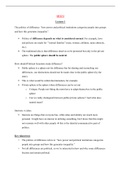Class notes
Lecture notes for The Politics of Difference (FY)
- Course
- Institution
The document includes lecture slides and notes, as well as some summaries of the readings (not all of them). It is mainly concentrated on the content of lectures since this will be the main focus of the exam.
[Show more]



